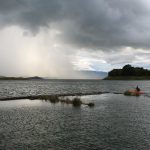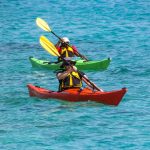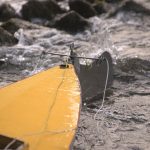Welcome to our guide on What to Wear While Kayaking!
Whether you’re a seasoned paddler or a beginner, choosing the right clothing and gear is essential for a comfortable and safe kayaking experience. With so many options available, it can be overwhelming to decide what to wear on the water.
In this article, we’ll provide you with valuable tips on how to choose the right clothes and gear for kayaking. We’ll also share some of the best brands and products that will keep you dry, warm, and protected from the sun and wind.
So, if you’re planning your next kayaking adventure, read on to learn what to wear to make the most of your time on the water.
How To Use This Guide
Before you start reading this article, take a moment to familiarize yourself with a list of terms we’ll be using to describe each article of clothing.
1. The best materials to look for when shopping are those that are durable and long- lasting.
2. The price range will give you an idea of what sort of product you can expect.
3. Your clothing will be most suitable to wear in certain conditions.
4. The type of kayaing you will be doing – River kayaking, whitewater kayaking, flat water kayaking, slalom kayaking, playboating, Surf Kayaking, kayak Polo, Outrigger Kayaking, Sea Kayaking, and Canoe Polo.
5. An ideal fabric has all the practical properties, but many are a matter of personal preference We will explain the qualities of an ideal fabric in practical clothing terms.
An ideal fabric has all the practical properties, but many are a matter of personal preference.
If you don’t know what to wear kayaking, follow these tips. This means that you should dress for the water temperature, not the air temperature.
What to wear while kayaking?
Layering
Before discussing the details concerning clothing for kayaking, let’s talk about the idea of wearing items in layers. Using multiple articles of clothing to control one’s body temperature by putting them on or taking them off is known as layering. Typical layers include a base layer, insulation and shell.
The garments that you put on directly against your skin are known as base layers and they help to keep you dry and comfortable by controlling moisture. Insulation is worn over base layers for warmth. Insulation is covered with shells to provide protection from wind and moisture.
When kayaking, layering clothes is distinct from what you’d do for other outdoor activities. However, by using a layering strategy, it is much easier to comprehend what to wear to ensure a pleasant and secure experience while kayaking.
Base Layers
Base layers are worn directly against the skin in order to keep sweat away by drawing it away. Base layers move sweat away from the body by dispersing it around the clothes and transferring the liquid from the inside outward.
The most commonly employed material for wicking base layers is polyester. It doesn’t absorb water and dries quickly. Merino wool is also used as a base layer. Merino wool may take longer to dry than polyester, however, wearing it while it is wet can still be beneficial as it keeps one warm, helps moisture to be truly wicked away from the skin, while not causing any foul smells.
Very little nylon textile is employed for wicking foundation attire, as it has a tendency to take on water and take a long time to dry. Nylon is not a suitable material to be used within a system of insulation.
Nylon has a low rate of drying which can be beneficial when looking for garments offering sun and heat protection. As a result, it is a common material found in clothing that is meant to be worn in warm weather.
Insulating Layers
Kayaking requires two kinds of insulation: wet and dry. As described in the beginning, wet insulation is designed to keep a person paddling in the water warm even when wet. A drysuit should typically be worn with a dry insulation layer underneath it, but multiple layers of wetsuits are also an option.
Out of the two types, dry insulation has more adaptability and can be employed for multiple outdoor exercises. Only when paddling and in frigid temperatures do people typically wear layers of a wetsuit.
Wetsuit layers are made of neoprene or similar materials. The more substantial the neoprene, the more efficient the wetsuit will be when it comes to preserving heat. Neoprene that is less thick offers greater flexibility and does not limit motion when paddling.
Wetsuits with no sleeves are often the warmest, even though they are less confining than thicker ones. These Farmer John (or Farmer Jane) one-piece wetsuits, which lack sleeves, provide plenty of warmth for the lower body and upper body and greater freedom of movement for the arms and shoulders.
Wetsuits that are less thick usually come in sections that could be mixed together for an ideal fit and enhanced performance. It is possible to switch out different layers of wetsuits to adjust for different temperatures; for example, wear shorts instead of pants in hotter climates, or long sleeves instead of short sleeves when it gets colder.
Lighter neoprene materials don’t impede motion as much as the bulkier wetsuits do, so many of these pieces come with extended sleeves to increase the warmth.
It is often recommended that wetsuits be put on without anything underneath them and be worn directly against the skin. Neoprene clothing intended for use during kayaking is fashioned to maximize efficiency and comfort while out on the water.
The stitching is placed in such a way that it prevents skin irritation, and the garments are tailored to make sitting in the boat comfortable.
Wetsuits don’t protect you from evaporative cooling. If you’re outside in the wind and you don’t have protection, you’ll get cold quickly if your wetsuit isn’t wearing an additional layer of fabric or clothing. You will have to have both a pair of pants and a jacket if you are using a wetsuit as a way of staying warm in chilly conditions.
Insulation that is not wet is akin to the layers of polyester fleece that are worn for other activities outside. The greatest distinctions are related to the styling and material used.
Most fleece materials employed for kayaking absorb moisture similarly to base layers and are capable of extending to provide an easier motion. Using a drysuit, moisture-wicking fleece assists in keeping your body heat from sticking to your skin by moving it to the exterior parts of your attire.
This implies that it will be less wet and more comfortable when out on the water. Conventional fleece fabrics don’t actively wick moisture. They will put in effort to paddle, but fleece that wicks away moisture does an even better job of controlling dampness and keeping one warm.
Insulating fleece provides the most warmth when it stays dry, but is still warm when it gets wet and dries quickly when it is saturated with water. Polyester fleece soaks up liquid speedily after going in the water and offers a ton of heat once you’ve gotten out. In the water, fleece offers little insulation. Therefore, fleece insulation should be worn under a waterproof material or with layers made of neoprene, which provides protection against cold water.
Fleece kayaking attire is made to decrease abrasion and increase pleasure while kayaking, much in the same way base layers and wetsuits are fashioned. The stitching is put far from the arm pits and the designs are changed so the upper garments and bottoms won’t separate while you are in your kayak.
No matter the climate, insulation is an essential component of any layering system. Using adequate layers of clothing and being aware of the weather conditions is essential for staying safe and comfortable in cold air and water.
Shell Layers
A layer of shells can be used to keep someone in a paddleboat dry and protect them from the wind. Both wet and dry clothing systems require shell layers. A wetsuit will not protect you from the wind and it is necessary to use an outer shell to prevent the body from cooling off due to evaporation.
The insulation provided by wicking fleece is the most effective when kept dry, which can be done by wearing a drysuit.
The shells of kayaks are normally made from material that is waterproof, and the joins between the layers have been bonded together in the factory so that water cannot penetrate them. Shell layers that are made using breathable materials are the most flexible.
These materials enable some sweat to leave the inside of the fabric. This assists in making you less wet and more relaxed while canoeing.
When one is engaging in strenuous exercise, sweat can be too much for breathable fabrics to handle, yet they still won’t make the wearer feel as damp as non-breathable coated fabrics do. The most comfortable ones to put on are definitely the best.
Kayakers who wear shell layers have designed closures at the neck, wrists, and ankles to stop water from entering. Neoprene or analogous wraps secure arm and leg openings more snugly than standard fastenings. The latex gaskets used in drysuits and drytops are even more dried out.
The rubber gaskets used allow for a snug fit around the wrists and neck to successfully keep nearly all the water from entering into the outfit. Some individuals consider this snug fit to be too restrictive, so they opt for closures that are not as watertight and can be adjusted for ease.
A drysuit is the ultimate shell layer for kayaking. This suit offers gaskets made of latex at the wrists and neck and often comes with socks that are designed to keep water out when worn with paddling shoes.
Drysuits constructed out of material which permits air circulation can be supplemented with components that are designed to move moisture away and supply warmth to create the widest variety of comfort and security in cold water.
Shell garments designed for hot temperatures mainly emphasize sun shielding and comfort rather than being resistant to water. Nylon paddling shirts and pants which are not considered as shell layers by definition are a good selection to remain cool under hot sunlight and in warm water.
What Shoes To Wear Kayaking
There are two main types of shoes designed for kayaking: neoprene shoes and water shoes. Sandals are also worth a mention.
Footwear made of neoprene goes from lightweight, pulling-on water socks to tall waterproof boots that reach up to the knee. The primary benefits of wearing neoprene shoes are the supple nature and the insulation they provide.
Neoprene retains its insulating properties even when wet and its sole, which is usually thin, can easily fit into the comparatively tight space of a more diminutive kayak. Waterproof neoprene boots are the driest and warmest option. Neoprene booties or socks that are thin and pliable are more comfortable to wear in hot weather.
Shoes made out of water-resistant material generally provide less insulation than neoprene shoes, but they usually offer more support. The most basic types of water shoes are just pull-on shoes with a thin sole to guard against any potential sharp objects.
Options that are more resilient have thicker soles that provide stability and cushioning when walking on land. The best choices come with lacing at the top that reaches higher than the ankle. The majority of water shoes are designed with tacky soles to provide traction on slippery surfaces.
Common elements found in many shoes include water drainage, uppers that provide additional support and heels that are low in height. Water shoes can be combined with neoprene socks to provide additional warmth when swimming in cold water.
Some kayakers prefer to be shod in water sandals in hot climates. Wearing sandals can be cozy on land, yet usually not enjoyable when in a kayak. The bottoms of water sandals are usually thicker than water shoes, so some boaters may find it challenging to get them into their kayaks.
Without padding on the back of them, sandals are not capable of providing any cushioning to keep a person’s feet safe from rubbing and pressure.
Extra Layers
Kayakers should bring additional clothing with them in their vessels when they depart for a day of being on the lake. It all depends on the location and weather in which you are canoeing as to which additional clothing you should wear. Even a hot day can turn windy.
Waves and spray can create an unexpected chill. For extended trips or when temperatures are lower, switching out insulating or base layers can help with both comfort and safety. In the nastiest weather, it could be sensible to bring an extra outer shell layer to cover your whole outfit.
No matter what the circumstance is, having the right extra clothing is a wise decision. Make certain to put them in a waterproof bag that will keep them protected from moisture if you ever requir
The List Of 5 Essential Gears That Should Be Worn While Kayaking
Many people enjoy kayaking as a great way to exercise and have fun. However, it is not without its hazards. Here are some things to keep in mind for your next kayak trip:
1. If you’re planning to paddle in the ocean or in cold water, you will need a life jacket that is buoyant and will keep you warm. Some important points to consider when choosing a life jacket are:
-Comfort
-Restrictions
-Buoyancy
-Warmth
A life jacket needs to be both buoyant and protective during bad weather. The water vest should allow for full range of motion of the neck and head to avoid discomfort.
The material needs to be waterproof so that water does not enter through any gaps in the fabric, preventing wet clothes from sticking.
2. The number of kayakers and paddlers in North America has increased dramatically in the past few years. The increase in kayaking and paddling has led to a higher number of accidents. Wearing a helmet can help prevent these accidents.
Many kayakers have found that wearing helmets while on the water can save their lives, as well as keep their heads safe in case they fall on their paddle or bump into something while paddling. While helmets with full-face masks are available, they can be difficult to put on and take off quickly when needed.
However, kayak instructors around the world are using a new product: facial guards. Guardian Helmets are designed to be more convenient to use than traditional hard hats. They can be easily slid on over your head and removed when necessary.
When you’re not using them, you can secure them over your ears.
3. Sunscreen provides protection against sunburns, sun damage, and skin cancer. The active ingredient in most sunscreens is a chemical that absorbs ultraviolet (UV) radiation before it penetrates the skin.
Some oils contain antioxidants which can help prevent the aging of skin. You should put sunscreen on 15 minutes before you go outside. When creating sunscreen for kayakers and paddlers, it is important to use ingredients that will provide broad-spectrum protection from the sun.
Depending on the kind of activities you love to do, there are many different types of sunscreen.
4. A pair of sunglasses is an essential piece of equipment for both kayaking and paddling. To ensure your safety, it is best to invest in a pair of headphones that have been tested and proven to work well in water.
5. Dry bags are waterproof bags designed to keep your belongings dry, whether you’re rafting down a river or biking through a rainstorm. They come in a variety of sizes, so you can find one to fit your needs, and they’re usually made from durable materials like nylon or PVC.
This type of device is most often used in kayaks or other small watercraft. Paddlers need to take care of their gear when they are out on the water as the dry bags can be easily damaged by water. There is no perfect dry bag for everyone, but there are many options to choose from that will suit different needs.
A different option would be better than this one if you plan to use the bag for cross-country skiing or bike touring. A dry bag is a bag that is durable and can keep your valuables safe while you are out on the water.
Dressing for Warm or Hot-Weather Kayaking
There is no need to dress up when kayaking in warm or hot weather. I enjoy paddling trips in the summer because I can wear less clothing and enjoy the (unfortunately few) months of Canada’s bright sun and heat.
There are a few items of clothing that are essential for kayaking in warm or hot weather.
Board Shorts/Swimsuit/Athletic Shorts
Women can kayak or paddleboard in a bathing suit or bikini. For those of us who are not confident enough to go kayaking in our underwear, a good pair of shorts is essential.
Any pair of board shorts, swim trunks, or athletic shorts made with quick-drying synthetic fabric will do for the most basic kayaking clothing.
UV-Resistant Shirt or Rash Guard
Your lower body will be inside the kayak, but most of your upper body will be exposed to the sun. You have a higher risk of sunburn and melanoma due to the UV radiation in sunlight.
It is recommended to wear a shirt with built in UV protection or a darker fabric with a denser weave to reduce the risk of skin cancer and shield from sunburn. The ideal material for your shirt is one that dries quickly, wicks away moisture, and is breathable.
It should also be comfortable to wear for extended periods, even when you are sweating.
Hat
A hat serves a number of purposes. It can protect your face from water and the sun. It also provides protection for your face and neck from too much sun exposure.
There are many different types of hats that will protect you from the sun. If you trust me, it can make a big difference after being out on the water all day.
Sandals/Flip Flops/Water Shoes
Many people prefer not to wear shoes while kayaking; however, I find it more comfortable to wear shoes as it provides a barrier between my toes and the pedals of the kayak. I find it more comfortable to push off the pedals when driving hard. After paddling barefoot for a few hours, my feet feel bruised.
Sandals are a shoes that many people in Canada wear and they are often good for kayaking. I don’t like to wear flip-flops when I’m paddling, but my wife prefers them to sandals.
My favorite shoes to wear are water shoes. They have a thicker rubber sole that provides good cushioning and a breathable mesh upper that allows water to drain out. I’ve been using the SIMARI water shoes for a while now and really like how light and thin they are.
But they also work well to protect my feet from both cold water and the hard plastic of my kayak pedals.
Spray Top
This piece of clothing is great for anyone who is kayaking out at sea because it will protect them from high waves and spray. The water in the ocean is much colder than the water in lakes or rivers, so the spray can be chilly on even the hottest summer day.
A spray top is a type of jacket that is a mix between a windbreaker and a rain jacket. It is made to be worn over a rash guard or athletic shirt and is waterproof.
I’ve only worn the WindRider Spray Top a few times, but it has made a big difference in keeping me warm and dry when paddling around Vancouver’s English Bay.
Dress for the Water Temperature, Not Air Temperature
This is an important tip to keep in mind when choosing what to wear kayaking!
While wind chill can make cold weather more dangerous, it is not always brutal. However, cold water is more dangerous than cold air because it leads to hypothermia faster.
Hypothermia can set in at relatively warm temperatures if a person is immersed in water, according to experts. Ambient temperatures of around 50 degrees Fahrenheit (10 degrees Celsius) can be enough to cause hypothermia if a person is submerged in water that is only 60-70 degrees Fahrenheit (16-21 degrees Celsius).
Your body’s natural reaction to cold water is to take in a deep breath, which can cause you to hyperventilate. You may start to feel anxious and panicky. You are at serious risk of hypothermia 10-20 minutes after being in cold water or if your clothes are wet and cold.
It can be, although the danger is usually overstated While cold weather can pose a threat, it is often overstated how dangerous it can be. The biggest threat you’ll face while kayaking isn’t the size of the waves.
When deciding what to wear for your next surf session, you should always consider how cold the water is. Even though you may feel like you’re wearing too many layers, it’s always best to be safe when dealing with cold temperatures.
Cotton Clothing: The Biggest No-No for Kayakers
Cotton is not a good fabric to use for A) most sports where you will sweat, and B) a base layer for cold-weather activities.
Why is that?
Cotton absorbs sweat readily, however it becomes heavy and soggy when wet, staying damp for some time. Since cotton dries slowly, the sweat stays against your skin. If you get salt crystals on your skin, it will cause friction and you will also get cold because the cotton fabric will be damp.
Cotton is great for hot weather but try to avoid it during winter. This is especially true when you’re in a situation where you could get wet.
In Conclusion
When you go kayaking again, you should have a better sense of the attire that will keep you cozy.
Search for fabrics that are airy and have a low weight so that you can move and paddle around comfortably, and keep the weather in mind!
You don’t have to have particularly specific apparel; all you need is to make sound wardrobe selections and do some research.




